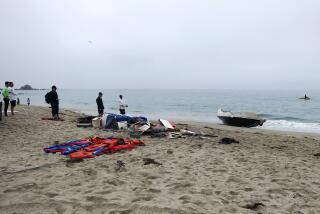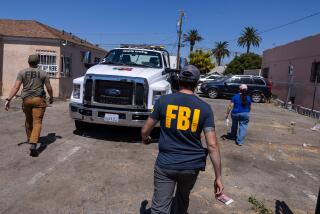Fatal incident reflects new boldness among offshore smugglers
The small Coast Guard inflatable vessel was 20 yards from the panga, an open fishing boat that law enforcement officers say has become the craft of choice to ferry untold numbers of marijuana bales and undocumented immigrants from Mexico to Southern California.
Spotted earlier by a Coast Guard cutter, the panga was running without lights, a standard practice in the illicit trade, according to investigators.
The four men on the boat dispatched from the cutter Halibut approached it cautiously, about 200 yards from the shore of Santa Cruz Island, off the Santa Barbara coast. In the darkness, they turned on their blue flashing lights and shouted, in English and Spanish: “Stop! Police! Put your hands up!” according to court documents filed Monday.
In response, the two men aboard the panga throttled their engines and headed straight at the small Coast Guard boat, ignoring shots fired by a crew member, provoking a collision that left a chief petty officer dead and his colleague injured. Then the two men kept going.
One of two men thrown out of the inflatable, Chief Petty Officer Terrell Horne III of Redondo Beach, died of a head injury caused by a propeller, according to the affidavit, which was filed in connection with the murder case against two suspects detained as they tried to flee to Mexico.
Officials say the tragedy underscores the dangers posed by smugglers who have foregone well-policed land routes in favor of the sea. Although more than 500 maritime smuggling incidents have been logged off the Southern California coast since 2010, this was the first violent death, authorities said.
“Most of our interdictions off of California can only be described as benign,” Coast Guard spokesman Adam Eggers said. “There may be an attempt to evade, there may be a short pursuit, but we haven’t had anything like this.”
The men on the panga, Jose Mejia Leyva and Manuel Beltran Higuera, both Mexican nationals, were charged in Horne’s death in U.S. District Court. Authorities believe they had been supplying gasoline to other smuggling craft operating off the California coast.
According to the affidavit, military aircraft followed their 30-foot craft as it made its way toward Mexico. With the two men futilely trying to restart their sputtering engine 20 miles north of the border, another Coast Guard vessel overtook them. Crew members demanded their surrender at gunpoint. When the men kept trying to start their engine, the Coast Guard crew doused them with pepper spray.
Encounters with seaborne smuggling have nearly doubled since 2010, with the steepest increases found along the more secluded, less patrolled beaches of Ventura and Santa Barbara counties, according to U.S. Immigration and Customs Enforcement.
In Santa Barbara County, the surge has alarmed local authorities. In an April letter to Rep. Lois Capps (D-Santa Barbara), Sheriff Bill Brown said the county experienced 16 “panga incidents” since the previous July, including the beaching of a four-engine, 45-foot “super-panga” that could easily have outpaced his department’s sole vessel.
“It’s a direct byproduct of increased pressure at the border and increased maritime enforcement to the south of us,” Brown said in an interview Monday. “They’re going further out to sea and they’re coming further north.”
Capps said she is asking federal agencies for additional enforcement funds in Santa Barbara.
The greatest number of coastal smuggling cases still occurs in San Diego, Orange and Los Angeles counties. But intensive interagency efforts based in San Diego and Long Beach have forced some smugglers farther up the coast, officials said.
“It’s not so much that efforts are being stepped up as that agencies are pooling knowledge and experience and expertise,” Eggers said. “The beautiful thing about Los Angeles is that there’s a ton of law enforcement here.”
Upgraded technology, such as infrared radar and enhanced video, is being shared among agencies, he said, along with “actionable intelligence.”
But smugglers have powerful incentives to take the risk. Dozens of people, paying an average of $6,000 apiece, can cram into each panga. Police say marijuana bales hauled by a typical panga can sell for millions. There’s a huge expanse of sea — the Channel Islands National Marine Sanctuary is nearly 1,500 square miles — and major roads, including U.S. 101, run right by potential landing areas.
Boat pilots often try to outrun law enforcement and some high-speed chases have ended with U.S. officers shooting out gasoline tanks or performing swerving maneuvers to stop the pangas, said a federal law enforcement officer who spoke on condition of anonymity.
“They aggressively try to get away, but not turn their boat on another boat like they did the other night,” the officer said.
On occasion, the rugged terrain of Channel Islands National Park has served as a staging area for smugglers.
In 2010, authorities seized 2,448 pounds of marijuana hidden in brush in a canyon on Santa Rosa Island, and arrested four people hiding nearby.
In 2011, 15 suspected illegal immigrants were stranded for three days on Santa Cruz Island, abandoned by the panga pilot who had transported them. They were rescued after calling 911 and hailing a boater.
Sunday’s incident at Santa Cruz Island occurred in Smugglers Cove, where tequila traders from Mexico once stashed their goods before the trip ashore, Brown said.
“To a certain extent, we have history repeating itself,” he said.
In June, six people were arrested as they unloaded 1.5 tons of marijuana from their panga at Santa Barbara County’s El Capitan State Beach. The Gaviota coast has been a landing spot for smugglers dating back to the Spanish colonial era.
Arraignment for the two men charged in Horne’s death has been set for Dec. 21.
In another panga case Monday, a federal judge took note of the weekend’s deadly encounter as he handed a sentence of nearly four years to a Mexican man whose marijuana-laden panga got stuck in rocks near Deer Creek Canyon in Malibu.
U.S. District Judge John F. Walter said the tragedy made it impossible to view the many sea smuggling cases on his docket as “lighthearted” capers.
“It has taken on now a much more serious tone in light of the events this weekend,” Walter said, adding, “Something needs to be done about this rash of panga boats.”
The defendant, Antonio Robles-Garcia, was arrested in January. His attorney, Dale Rubin, said he had signed on because was desperate to get to the U.S. and work.
Times staff writers Richard Marosi and Harriet Ryan contributed to this report.
More to Read
Sign up for Essential California
The most important California stories and recommendations in your inbox every morning.
You may occasionally receive promotional content from the Los Angeles Times.











